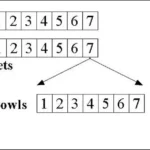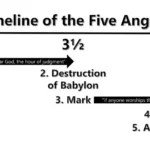Introduction
The Roman Emperor Nero who reigned from 54 A.D. till his death by suicide on June 9th, AD 68 is often thought of the most evil of all Roman Emperors. The famous painting pictured above by Polish painter Henry Siemiradzki1 painted in 1876 depicts how Nero punished the Christians after blaming them for the burning of Rome in AD 64 and so as a punishment he burned them on stakes at his garden parties and made sport of them. Also, Christians were fed alive to animals in the arena, burnt at the stake, and greatly tortured. It would seem that Nero makes a very good candidate for being the Antichrist.
Four major views of eschatology
So, in light of the evil committed by this first century tyrant, was it Nero? He is often cited by Christian eschatologists as being the literal Antichrist who was prophesied in the book of Revelation. But of course when you talk about the book of Revelation being written in AD 96 by John the Apostle and Nero reigning from AD 54 to 68 then this means that effectively John’s revelation was a history book rather than a prophetic future vision. There are many modern “biblical scholars” who see Revelation, the tribulation period, and the Antichrist as either symbolic, poetic, or historical rather than in the future. And this in fact delineates four major views of the end times.
Historicism
Those who see the book of Revelation as containing actual historical events or figures and see the book of Revelation as a symbolic presentation of church history beginning in the 1st century are known as “historicists.” They see the Pope being the Antichrist. The majority of the Protestant reformers such as Martin Luther and John Calvin held this view.
Preterism
Another eschatological view is preterism which comes from the Latin praeter, meaning “past.” Thus, preterism is the view that the biblical prophecies concerning the “end times” have already been fulfilled—in the past in AD 70 upon the destruction of the Jewish temple. According to preterism, all prophecy in the Bible is really history and that makes sense with respect to Nero being the Antichrist as he preceded John’s Revelation by some 30 years. In my opinion both historicism and preterism are erroneous because even though you can see patterns in history, there are also many holes that cannot be explained.
Futurism
In contrast those who see the Antichrist as being a prophecy and yet to come are known as “futurists.” Futurists see the tribulation period as yet to occur and take a pre-millennial view which basically places the future 1000 year millennial reign of Christ in the future after the tribulation period. This is the 7th day of the seven millennia believed by the early church fathers. It is known as chiliasm which was the predominant view in eschatology in the first few hundred years of the church.
What did the early church fathers believe?
There are several reasons why the preterist view that Nero was the Antichrist is a false theory. Firstly, the early church fathers did not believe this or promote this view. Irenaeus, the bishop who knew Polycarp and was believed to have the last living connection with the Apostles never saw Nero as being the Antichrist despite Nero being part of his recent previous century history just as we know of the evil reign of terror of Adolf Hitler some 70-80 years ago. The historical view sees the beast that rises from the sea in Rev. 13:1 as being imperial Rome and the lamb-like beast that comes up out of the earth in Rev. 13:11 as being imperial Rome in Asia Minor (Turkey and the east) where Nero was greatly admired partly because he liberated much of the provinces away from Rome and rewarded them. We see that the second lamb-like beast acts in a much more gentle way than the first beast,2 hence the two horns of a lamb. Ancient Rome however was not as nuanced and as deceptive as the future end times ruler will be because the end times ruler will be very deceptive even being able to deceive the very elect into beast worship.
Nero is also seen as fitting Rev. 13:3 and the revival of the beast after a fatal head wound. In the end, Nero stabbed his throat with the aid of one of his servants in June AD 68 when he ran out of supporters and death was near. There is no record of Nero having come back from the dead at this time. The myth was known as Nero Redivivus3 and was widely held despite several imposters arising. In my opinion, this is a myth that will remain a myth despite some claiming that a revived Nero could be the futuristic Antichrist. This does not, in my opinion, fit all the clues as to the Antichrist’s identity. Yes, he did have a fatal head wound of sorts but it was in the throat, not the actual head as such. Yes, he was very evil and persecuted Christians who were often confused with the Jews. Christianity was considered to be a sect of Judaism at the time. What is certain however is that Nero is absent in the earliest available church sources as being the Antichrist and that the first known interpretation to this effect must be dated no earlier than AD 300 and perhaps later than AD 400. If Nero was the Antichrist then one would think that the early Christian fathers would have supported this view.
Nero = 666?
One of the most popular reasons for Nero being the Antichrist as part of the historical view is that the number of his name seems to add up to 666. But again Irenaeus did not have any firm views as to the number 666 being the number of anyone that he knew about including Nero whom he would have definitely known about. He was particularly cautious about this very fact in his writings. Many modern biblical scholars are reluctant as well to ascribe the number 666 to Nero because of the fact that only if the Greek spelling of Nero Caesar (Neron Kaisar) is transliterated into Hebrew (nrwn qsr), is the numerical equivalent 666. This seems to me to be a long shot as we move from Latin to Greek to Hebrew to try and get the right result. I still don’t believe that we know how to calculate the number of the beast but once he arrives this number will become known.
A big error in the preterist view
A big error in this whole theory is just who is the second beast in the preterist view? The book of Revelation insists that it is a man, a false prophet in fact, whereas preterism sees the second beast being the eastern Roman Empire where Nero was well-liked. Rev. 13:11-16 uses male personal pronouns and Rev. 19:20 calls him the false prophet, a man, which discounts it being the whole eastern part of the Roman Empire.
Dual fulfillment of prophecy
The destruction of the temple and Jerusalem in AD 70 does seem to fit Jesus’ description of the end times in Luke 21:20. The 4th-century church historian Eusebius cites a tradition that Christians escaped to Pella beyond the Jordan River when Titus’ 10th legion army surrounded Jerusalem.4 They knew that it was time to escape and many Jerusalem Christian’s lives were saved because they knew the prophecy of Jesus. They probably took it as meaning that the end times were being fulfilled right then and there because the whole related passage ties up very closely with the Matthew account in Matthew 24. But as I have mentioned before, there are often dual fulfillments of prophecies. The initial surrounding of Jerusalem can be seen as a harbinger of what is to come in the final seven years as well. Jerusalem will be surrounded again but Matthew makes it clear in his account that when you see the Abomination of Desolation that that is the sign that we are to look for as to when to flee to the mountains. It seems like the two passages are talking about two different times.
Nero was a buffoon
Another argument against Nero being the Antichrist is that he was referred to by his honourable tribune, Flavius, as being a buffoon upon his death. Nero often dressed as a woman and liked to play the clown and perform in front of audiences amusing them with tricks and jokes and odd gestures. This is a buffoon to be exact. Nero was not a stern-faced dictator type ruler5 as befitting the end times ruler although to be fair Nero was seriously evil and did many evil acts. The final evil ruler will be a man who speaks obscenities and will lead many astray using only his mouth and words. The beast was given a mouth to speak proud words and blasphemies.6 All three members of the false trinity have in common the fact that they are endowed with the faculty of speech in being able to deceive. Even the power of the demonic locusts in Rev. 9:19 is in their mouths. The fact is that only Adolf Hitler matches these criteria in being able to command people by his mouth and his words alone. In fact, everything that Hitler achieved was by his mouth and words and oratory skills. He had a fierce countenance and he was no buffoon.
The only view that makes total sense is futuristic
In my opinion, Nero, in the first century does not fit all the clues as to the identity of the Antichrist described in Revelation. Some clues seem to fit if forced but it is like trying to fit jigsaw pieces into a jigsaw that don’t quite fit. You think they fit when forced a little then a better piece comes along in the form of Adolf Hitler, the great antagonist of the Jews. Furthermore, the historical view of the tribulation, the Antichrist, and the book of Revelation is a false theory. The only view that fits perfectly is to take these end time’s prophecies as futuristic. It also fits the early church father’s chiliastic view of the end times in that God will deal with man for 6000 years and then 1000 years during the millennial kingdom replicating a prophetic week with one day = 1000 years. When you closely examine the Bible it tells you unequivocally that the earth’s history is now 6000 years old. See “Chronology for everybody” by Ruth Beechick for proof of this 6000 year Bible chronology.7
Nero is not that man
So, how does this help us right now? It helps us because we can stop thinking that Revelation is really just history. Yes, it is written in the past tense but it is what we call the prophetic past tense. John saw it as having been already completed but this was a vision. This can be confusing but we need to look to the future and the time and signs tell us that Christ is right at the doorstep and soon to come back. There are still a few key prophecies yet to be fulfilled before He comes back like the Two Witnesses, one being Elijah or a type of Elijah, and the final Jewish temple being rebuilt. The prophecy of Damascus becoming a heap of ruins has never before happened in history either.8 Nero was an extremely evil man and he did many evil acts including his persecution against Christians and to be sure he was one of many antichrists.9 But he was not the Antichrist and he is not the one who is still yet to come. According to Revelation, the future beast will astonish the world because he is a historical tyrant who comes back to life but I do not believe that Nero is that man.10 He is a jigsaw piece that does not quite fit the puzzle.
- https://en.wikipedia.org/wiki/Henryk_Siemiradzki [↩]
- Rev. 13:11 [↩]
- https://en.wikipedia.org/wiki/Nero_Redivivus_legend [↩]
- https://en.m.wikipedia.org/wiki/Flight_to_Pella [↩]
- Dan. 8:23 [↩]
- Rev. 13:5 [↩]
- https://creation.com/images/pdfs/tj/j15_3/j15_3_67-73.pdf [↩]
- Isaiah 17:1 [↩]
- 1 John 2:18 [↩]
- Rev. 17:8 [↩]

















2 Responses
“Assuredly, I say to you, there are some standing here who shall not taste death till they see the Son of Man coming in His kingdom.” -Matthew 16:28
You do not have to look very far to see that this statement was actually fulfilled in the very next verses, Matt. 17:1-13, on the mountain where Jesus was transfigured. Luke 9:31 NIV tells us that Moses, Elijah and Jesus appeared in glorious splendour talking with Him about what was to happen. But a more literal translation says, “They appeared in glory and were speaking of his departure,” Luke 9:31 NRSV. They actually saw Jesus appearing in glory so they did see the Son of Man as He would be coming in His kingdom. This does not mean that they would see Jesus coming back literally in their lifetime.
France’s Commentary on Matt. 16:28 says, “This was a unique experience granted to those three alone; the rest of the Twelve would not see anything like that before they died. It may be questioned whether the vision on the mountain fully matches the promise of “seeing the Son of Man coming in his kingship,” as that kingship was yet to be established after his death and resurrection — hence, no doubt, Jesus’ instruction in 17:9 to keep the vision secret until after the resurrection. But it is likely that Matthew (and Mark and Luke, who use the same awkward phrase about “some of those standing here” and equally closely link that saying with the following account of the Transfiguration) saw in this vision at least a proleptic fulfillment (flash forward) of Jesus’ solemn words in v. 28, even though the truth of Jesus’ kingship was to be more concretely embodied in later events following his resurrection.”